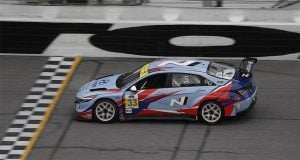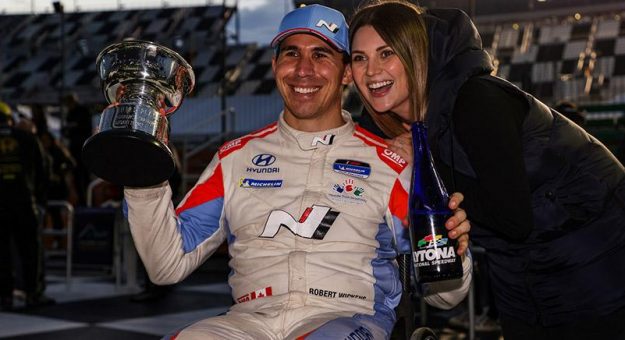DAYTONA BEACH, Fla. – Deep in the comments of one of Robert Wickens’ Instagram posts is one from someone he’s never met: You’re so inspirational.
It could have been any of the 319 comments on a workout video viewed more than 33,000 times. Like many of the comments, inspiration is the theme.
Wickens didn’t intend to be an inspirational figure. He didn’t share the agony, challenges and progress of his rehabilitation or the photos of his wedding, standing with his wife Karli, for clicks.
The original intent, however, has been achieved.
“My wife and I didn’t publicly share our recovery journey just to get comments or attention,” Wickens explained. “We did it to try to raise awareness for what spinal cord rehabilitation looked like. We didn’t expect the ripple effect of how it would inspire people.”
It has inspired people, again and again. His return to racing last month became the story of the days leading up to the Rolex 24 At Daytona. His posts of a third-place finish in the IMSA Michelin Pilot Challenge race drew tens of thousands of views and thousands of comments. Always, inspiration emerged as the primary topic.
“You don’t expect to really have that big an influence on somebody,” Wickens said. “I didn’t become a race car driver to influence or motivate, but it’s the power of the sport. I’ve always believed that my voice is in my work. I’m not a particularly over-spoken person, but I always like to lead by example and by showing that hard work will always pay off.”
In ways that can’t be measured by clicks and comments, his hard work has paid off. Forty-one months after a crash left him paralyzed, Wickens is racing again. His story isn’t his as much as everyone’s, a contact point for understanding and motivation and hope.
“I’m just one of thousands who deal with spinal cord injuries every day,” Wickens said. “It just so happens that I have a relatively strong platform to share the journey.”
‘It’s Something Bigger than Racing’
A Formula One test driver in 2011, Wickens further established his professional career during six seasons in Deutsche Tourenwagen Masters (DTM), posting six wins and twice finishing among the top five in championship points. A promotional ride swap at Sebring between Wickens and fellow Canadian James Hinchcliffe in 2017 eventually led to Wickens signing with Schmidt Peterson Motorsports for the 2018 IndyCar Series season.
In his first race, Wickens won the pole position at St. Petersburg, then led 69 of 110 race laps before contact on the final restart ended his chance at a win. He finished among the top five in seven of the next 12 races. But his car went airborne at Pocono Raceway and tore into the fence, leaving Wickens with severe injuries: a thoracic spinal fracture, a spinal cord injury, a neck fracture, fractures to the tibia and fibula in both legs, fractures in both hands, a fractured right forearm, a fractured elbow, four fractured ribs and a pulmonary contusion.
Months of rehab followed as Wickens attempted to regain movement in his legs, but his recovery eventually reached a plateau. He talked with Bryan Herta, whose Michelin Pilot Challenge team was fielding a car with hand controls for paralyzed driver Michael Johnson in the Touring Car (TCR) class.

“I’m not regaining any more muscle function,” Wickens said after signing with Bryan Herta Autosport with Curb-Agajanian in January. “Unfortunately, it’s looking like I’ll be in a chair for the remainder of my life as long as modern medicine and science stays where it is.”
That’s when the enormity of the attention surrounding Wickens’ story became clear to Herta. Before and after Wickens and teammate Mark Wilkins finished third in the Touring Car (TCR) class in the No. 33 BHA Hyundai Elantra N TCR, Wickens was the center of attention at Daytona, followed by reporters and fans and a camera crew filming a documentary.
“The reaction we had rivaled the amount of interest in the overall winner in the 24-hour race – that’s how big it was,” Herta said. “You can’t explain that in any other way than it transcends racing.
“Anybody who was even tangentially interested in motorsport knew about it at the time. You connect to it. You imagine if that was you or someone you cared about. It’s just a natural human thing to put yourself in that position and try to relate to and understand what that really means. Somebody’s life changed in a moment, and the life of everybody around them has changed.”
True, Wickens’ life has changed. Also, in a significant way, it is back to normal.
“It was exactly what I needed,” Wickens said of Daytona. “I say this is just the beginning because my goal is to return to an elite level of motorsport, to a level I was at prior to my injury.”
Herta is there – along with everyone else in racing – to make that happen.
“We’re all emotionally invested in this,” Herta said. “We’ve got six cars and 12 drivers, and we want them all to be successful. We try to put our best effort into all of them. But with Robby, it’s emotional.”
Wickens understands the notion of emotional investment; he’s been emotionally invested in his own career since he was a kid in karts. He didn’t expect the attention he’d receive for this part of his career, though. Neither did Herta.
“It’s a redemption story, a comeback that everybody can feel good about and see some kind of positive in,” Herta said. “There’s not an end to the story yet. To see him overcome and provide hope is what it is.
“We all hope that we can overcome challenges in our lives. To see somebody like Robby overcome a challenge far greater than any of us can ever face, on the human side it just gives you hope. If he can get through that, I can get through whatever it is in my life that’s holding me back right now.”
Podium at Daytona Is Only the Beginning
Wickens’ story connects with strangers the same way it connects with those closest to him. It’s a story of recovery and perseverance, of a negative turned positive, of finding and rediscovering what was thought lost. He wrestles with it himself. He understands the effect it has on other people.
“I was at the pinnacle of my career and the best I’d ever been,” he said. “I spent my 20s perfecting my craft and being a professional inside and out and doing what needed to be done. … I felt like I had a lot to accomplish there. When that was taken away from me, that’s what stung the most. That’s what drove me to get back.”
A podium finish, a trophy and a spray of champagne were the tangible rewards, but the intangible rewards lie beneath the surface. The first goal has been met. More goals, beginning next month at Sebring, lie ahead.
“Daytona was validation that I can return to an elite level of motorsport,” Wickens said. “This is really just the beginning of the journey. I plan on making the most of it.”
Wickens and the rest of the Michelin Pilot Challenge field return to action March 17 with the Alan Jay Automotive Network 120 at Sebring International Raceway. Livestream coverage is available on Peacock starting at 4:20 p.m. ET, with IMSA Radio also broadcasting the race.
